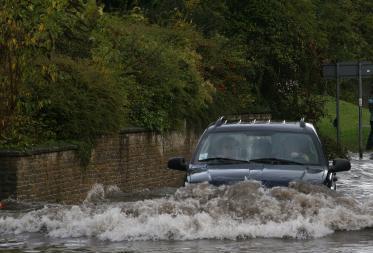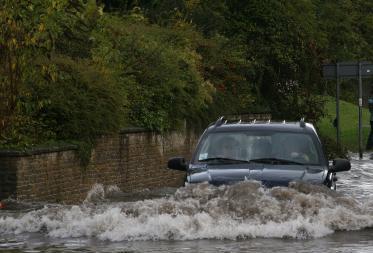The industry’s image took a battering after the floods of 2007. But the blame was in part misdirected: a review of the UK’s flood defences found most of the problems were caused by a lack of co-ordination between agencies. Lauren MacGillivray finds out more
After living on Corve Street in Ludlow for 41 years, Sol and Doreen Pearce watched their house crumble into the flood waters of 2007.
The heart-wrenching moment that left the Shropshire couple homeless was broadcast around the world, on news stations and YouTube.
Eighteen months on, the government has just published its response to the Pitt Review on flood defences and the Pearces are settled in a bungalow on nearby Whitbatch Close. There is a garden where their home used to be.
Not everyone has been rehoused, however. Last November, 1,000 families across the UK were still waiting to move back into their homes or living in the top floor of damaged properties. About 100 were living in caravans.
Last week, East Riding of Yorkshire council, which represents one of the areas worst affected by the floods, said about 180 local people were not back in their homes. Sixty were in caravans.
It’s natural to lay blame in cases of such long-lasting misery – insurers, for one, have had their names dragged through a fair bit of mud.
A council spokesman says some residents have complained about disagreements with insurers over claims, including content and schedule of works. The residents also said they had been passed around between different loss adjusters and had had trouble finding reliable contractors. Loss adjusters also sometimes failed to pay builders and contractors.
Last month, John Healey, the floods recovery minister, vowed to take up personally any insurance problems. And the Pitt Review found that 22% of people affected by the floods were either dissatisfied or very dissatisfied with their insurers.
The consensus, however, was that most insurers – who have paid out about £3bn following 180,000 claims – did a good job.
The main cause of the delays seems to have been the lack of co-ordination between government, local authorities and water and sewerage companies. But these groups have now started to work together.
Government
Late last month, the government published its response to Sir Michael Pitt’s June 2008 study.
The action plan from the Department for Environment, Food and Rural Affairs said national and local government should take more responsibility.
Under the government’s proposals, the Environment Agency will manage overall flood risk while local authorities will be responsible for organising plans for surface water – which caused up to two thirds of the flooding in 2007.
Hilary Benn, the environment secretary, said: “All of us – government, local communities, providers of essential services such as water and electricity, and individuals – must take flood risk seriously. We need to act to reduce the risk where we can, and be ready to step in with effective help and recovery arrangements.
“Our £2.15bn investment in flood defences and coastal erosion management over the next three years ... will help achieve this.”
The government plan also includes:
- A £7.7m flood warning centre. It will be run by the Met Office and Environment Agency and will complement the agency’s existing public flood warning system. Benn said: “Preparation and speed of response are crucial. A joint national flood forecasting and alert service will help by providing timely warnings and ensure we get the right help to the people who need it most in the shortest possible time.”
- £15m to help councils co-ordinate and lead flood management. They will manage the risk of surface flooding, and will have to produce a co-ordinated plan for dealing with local flooding. Six local authorities have received the first tranche of funding to develop plans for dealing with surface flooding after extreme rainfall. They will also have to assess the risk and predict where it could happen.
- £5m to help homeowners install flood protection such as door boards.
- Up to £2m to improve water (boat) rescue services.
- Up to £1.25m for local resilience forums, in which representatives of the emergency services prepare contingency plans to cope with the failure of reservoir dams.
- An extra £8.5m for the Environment Agency to make flood warnings more widely available, improve how surface flooding is predicted and mapped, and help it implement other recommendations.
- The government wanted the ABI to issue guidance on flood claims and repair timescales – but has since acknowledged this has already been done. The guidance, prepared with the Chartered Institute of Loss Adjusters, will be distributed after the next major flood.
- Flood maps for reservoirs coming under the Reservoirs Act 1975 will be prepared and provided to local emergency planners by the end of this year.
Insurers
Meanwhile, the ABI is launching a consultation this week aimed at planners, builders and local authorities. The consultation, which closes in March, will gauge reaction to the association’s new draft guide on how to make sure properties remain insurable. This could include ideas such as building flood-resilient homes.
The initiative follows Pitt’s recommendation that insurers educate the public about products that cover flooding.
In July the ABI renegotiated the statement of principles on flooding with the government. The agreement, which ends in 2013, guarantees that flood cover will remain widely available for existing homes and small businesses at risk of flooding – provided certain conditions, such as a long-term investment strategy from government, are met.
But the agreement does not apply to properties built after 1 January this year. This makes initiatives such as the ABI’s draft guide vital. It is also possible that the draft Floods and Water Bill, which is expected this spring, will include measures to make homes
flood-resilient. Insurers could be told to impose tougher flood-resilience standards on rebuilds.
Water and sewage
Some insurers regarded water and sewerage companies as the “bad guys” after disagreements over who was responsible for some of the damage done to homes in 2007.
Norwich Union considered legal action against Yorkshire Water after an independent review on the flooding in Hull found that the water company had failed to act on a number of warnings about drainage systems.
But last week, Jason Harris, senior claims manager at Norwich Union, said there was not enough evidence to pursue an action.
Sewers and drains have a direct impact on surface water. The government now wants local authorities to take the lead on surface run-off and ground flooding, for which there is currently no responsible authority. But they will also delegate part of the task to water and sewerage companies.
Meanwhile, Ofwat, the regulator of water and sewerage companies in England and Wales, is running a consultation on improving sewer flooding risk registers, while water suppliers have proposed capital spend of £1.6bn over five years to help prevent sewer flooding.
Pamela Taylor, chief executive of Water UK, which represents the suppliers, said the industry was addressing the lessons learnt from 2007. “As a matter of priority, companies have moved to carry out a complete review of emergency procedures, including the volumes of water required during a major supply interruption, the manner in which companies provide mutual aid during large incidents and the interaction between companies and consumers in such events.”
She said the industry had also looked at where capital investment might be needed to protect critical assets from flooding and at reducing the number of properties at risk from overloaded sewers. These areas had been incorporated into business plans.
In a separate move, the government last month announced that England’s privately owned sewers and lateral drains – the part of the pipe that runs from the property boundary to connect to the sewer – would be transferred to water and sewerage companies by 2011.
Currently, water and sewerage companies look after the 300,000km of public pipework but not the 200,000km of privately owned sewers and lateral drains. The plan is expected to help improve surface water management. It is also expected to have a knock-on effect for insurers, although not all policies cover wear and tear.
Mapping
Predicting flood risk is still difficult – and there is more than one map trying to do the job. The Environment Agency has two maps: one on river and sea risk, and one on surface water, created since the Pitt Review. This second map uses digital terrain and rainfall data and has been distributed to local emergency services, such as the fire service and police.
Some insurers have also attempted to map flood risk. Norwich Union has created a river-related risks map with consultant JBA. It also wants to produce a drainage map, but says it has not been able to obtain the necessary data. Simon Black, head of mapping at the insurer, said last year he wanted to find a company that could map the UK’s entire drainage system because no maps were available. He also said water companies had not been forthcoming with their drainage data – something he hoped the government would encourage them to do.
The latest flood mapping data from Risk Management Solutions, which has been incorporated into Landmark’s environmental risks reports for the property industry, has encountered similar problems. Its map includes rivers and surface water risk, but no drains.
According to the ABI, about 80,000 properties are at very high risk of flooding because of poor drainage and an increase in concreted areas. Every year 6,000 homes are hit by sewage flooding. This makes the mapping of drains and sewers all the more important.
The government plans to include a provision in the Floods and Water Bill requiring all bodies involved in flood and coastal erosion risk management to co-operate and share relevant information. This could include data for maps.
The government also intends to provide local resilience forums with inundation risk maps for reservoirs. The Environment Agency is on track to produce these by the end of this year.
Hosted by comedian and actor Tom Allen, 34 Gold, 23 Silver and 22 Bronze awards were handed out across an amazing 34 categories recognising brilliance and innovation right across the breadth of UK general insurance.











































No comments yet